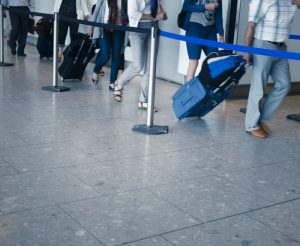 If cognitive computing were adopted widely by companies in the travel industry, what would a typical trip look like for a business traveler? Might some of your biggest travel frustrations be relieved? Let’s find out.
If cognitive computing were adopted widely by companies in the travel industry, what would a typical trip look like for a business traveler? Might some of your biggest travel frustrations be relieved? Let’s find out.
It’s a beautiful day, and you have an important customer briefing in LA. You’ve already received a text that your flight is on time. Monday morning is one of the busiest times at the airport, and naturally you’re running a tad late. You start to worry about finding a spot to park in the packed airport garage, but then your navigation system uses image detection to direct you right to the best open spot. Without realizing it, you got one of the last four spots in the main parking lot.
How did this happen? Using convolutional networks, the computer can analyze photos of the parking lot in real time and detect images with a 6 percent error rate, which is better than the human eye.
After parking and rushing into the airport, the guy in front of you is stopped at the security check-in because of an oversized can of deodorant. This causes a little bit of a delay, but you feel safer knowing a highly accurate machine with image recognition is scanning bags instead of just an overworked security agent.
After passing through security uneventfully, you are back on track timewise and decide to get a coffee and something to read. While approaching the book store, you are notified of special promotions based on your reading history. Then, at checkout you receive a coupon for gardening and classic car magazines, based on a recommendation system that knows these are your hobbies. You might decide to use the coupon during your changeover at DFW.
Just as you’re downing that last drop of black coffee and starting to wonder why your co-worker hasn’t arrived at the gate, she receives a warning that she’s was in the wrong terminal and instructions on the quickest route to the correct gate. Location services have long been used to route planes. Now, they can also be leveraged to better move passengers along and help assure that flights are on time.
Finally, your co-worker makes it to the gate, and you both settle in for the long flight to LA. After takeoff, you use the in-flight Wi-Fi to tweet:
RDU > LAX leaving on time. No complaints here. First leg of this busy travel day could have been ugly but was not.
The airline picks up and interprets your tweet as positive, using entity extraction and sentiment analysis, and replies with:
Thanks! We hope the rest of your day goes as smoothly. Should be sunny and 80 in LA when you arrive.
Closing out Twitter and opening PowerPoint, you make a few final changes to your presentation and then relax and enjoy the personalized airline entertainment options. Everyone is kicking back enjoying the beautiful day ahead, including the pilots because the plane is truly flown virtually and autonomously.
Learn more about cognitive computing.
